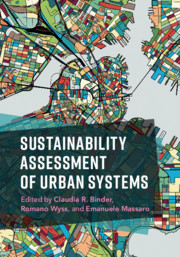Book contents
- Sustainability Assessment of Urban Systems
- Sustainability Assessment of Urban Systems
- Copyright page
- Contents
- Preface
- Acknowledgments
- Contributors
- General Introduction
- Part I Theoretical Background
- Part II Integrative Approaches for Sustainability Assessment
- Part III Perspectives on Urban Sustainability
- Part IV Focal Points of Urban Sustainability
- 15 Energy Challenges in Urban Systems
- 16 Sustainability Assessment of the Housing System: Exploring the Interplay between the Material and Social Systems
- 17 Sustainability Assessment of Urban Agriculture
- 18 Cities and Entropy: Assessing Urban Sustainability as a Problem of Coordination
- 19 Conceptualizing Urban Systems for Ecologic Sustainability Assessments: Case Study of the Stockholm Royal Seaport City District
- 20 A Study of Ride-Sharing Opportunities in the City of Santiago de Chile
- 21 Mosquito-Borne Disease and Human Mobility in Urban Environments
- Index
- References
16 - Sustainability Assessment of the Housing System: Exploring the Interplay between the Material and Social Systems
from Part IV - Focal Points of Urban Sustainability
Published online by Cambridge University Press: 27 March 2020
- Sustainability Assessment of Urban Systems
- Sustainability Assessment of Urban Systems
- Copyright page
- Contents
- Preface
- Acknowledgments
- Contributors
- General Introduction
- Part I Theoretical Background
- Part II Integrative Approaches for Sustainability Assessment
- Part III Perspectives on Urban Sustainability
- Part IV Focal Points of Urban Sustainability
- 15 Energy Challenges in Urban Systems
- 16 Sustainability Assessment of the Housing System: Exploring the Interplay between the Material and Social Systems
- 17 Sustainability Assessment of Urban Agriculture
- 18 Cities and Entropy: Assessing Urban Sustainability as a Problem of Coordination
- 19 Conceptualizing Urban Systems for Ecologic Sustainability Assessments: Case Study of the Stockholm Royal Seaport City District
- 20 A Study of Ride-Sharing Opportunities in the City of Santiago de Chile
- 21 Mosquito-Borne Disease and Human Mobility in Urban Environments
- Index
- References
Summary
The chapter focuses on the housing sector as an important component of urban systems. It advances a broader understanding of the interplay between the material system (material and energy resources used in housing systems) and the social system (social norms, traditions) as a part of an integrative sustainability assessment of housing. To guide our analysis, we adopt different methodological approaches, which allow us to couple the material management goals derived from the analysis of the material system with the social options and constraints that affect whether these goals are achieved. This takes place, more specifically, in the context of shrinking housing size. We propose a set of indicators for assessing the housing system. Additionally, we display their interrelations, and the roles they play within the system: we identify the indicators that drive or monitor the performance of the housing system and subsystems, and the actors, life-cycle stages, and material management goals that these address. Finally, we propose to use this approach for analysing and assessing the current state of the housing system, but also for governing it and addressing the need for shrinking housing’s environmental footprint.
- Type
- Chapter
- Information
- Sustainability Assessment of Urban Systems , pp. 384 - 416Publisher: Cambridge University PressPrint publication year: 2020

